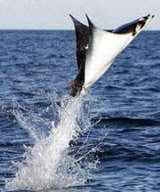
Devil fish
Encyclopedia
The devil fish or giant devil ray (Mobula mobular) is a species of eagle ray
, family
Myliobatidae. They are most common in the Mediterranean Sea
and can be found elsewhere in the Eastern Atlantic Ocean
, off the southwest coast of Ireland
and south of Portugal
.
It is larger than the lesser devil ray
, growing to a maximum length of 520 centimetres (204.7 in), and it possesses a spiny tail. The species feeds on crustacean
s and small schools of fish.
The devil fish has a limited range and a low rate of reproduction. As a result it is sensitive to environmental changes. The main threats to this species come from pollution in the Mediterranean and accidental, unintended capture in various fishing equipment including trawls, tuna traps, and dragnets meant for swordfish
, none of which are intended to ensnare Giant Rays. The 2004 IUCN Red List
listed the devil fish as a vulnerable species, but in 2006 it was reclassified as an endangered species.
Eagle ray
The eagle rays are a group of cartilaginous fishes in the family Myliobatidae, consisting mostly of large species living in the open ocean rather than on the sea bottom....
, family
Family (biology)
In biological classification, family is* a taxonomic rank. Other well-known ranks are life, domain, kingdom, phylum, class, order, genus, and species, with family fitting between order and genus. As for the other well-known ranks, there is the option of an immediately lower rank, indicated by the...
Myliobatidae. They are most common in the Mediterranean Sea
Mediterranean Sea
The Mediterranean Sea is a sea connected to the Atlantic Ocean surrounded by the Mediterranean region and almost completely enclosed by land: on the north by Anatolia and Europe, on the south by North Africa, and on the east by the Levant...
and can be found elsewhere in the Eastern Atlantic Ocean
Atlantic Ocean
The Atlantic Ocean is the second-largest of the world's oceanic divisions. With a total area of about , it covers approximately 20% of the Earth's surface and about 26% of its water surface area...
, off the southwest coast of Ireland
Ireland
Ireland is an island to the northwest of continental Europe. It is the third-largest island in Europe and the twentieth-largest island on Earth...
and south of Portugal
Portugal
Portugal , officially the Portuguese Republic is a country situated in southwestern Europe on the Iberian Peninsula. Portugal is the westernmost country of Europe, and is bordered by the Atlantic Ocean to the West and South and by Spain to the North and East. The Atlantic archipelagos of the...
.
It is larger than the lesser devil ray
Lesser devil ray
The lesser devil ray, Mobula hypostoma, is an eagle ray in the genus Mobula.These rays live in shallow coastal waters and can be found singly or in large shoals. The feed on crustaceans mostly, but will sometimes feed on shoals of smaller fish. Lesser devil rays are relatively small, with a maximum...
, growing to a maximum length of 520 centimetres (204.7 in), and it possesses a spiny tail. The species feeds on crustacean
Crustacean
Crustaceans form a very large group of arthropods, usually treated as a subphylum, which includes such familiar animals as crabs, lobsters, crayfish, shrimp, krill and barnacles. The 50,000 described species range in size from Stygotantulus stocki at , to the Japanese spider crab with a leg span...
s and small schools of fish.
The devil fish has a limited range and a low rate of reproduction. As a result it is sensitive to environmental changes. The main threats to this species come from pollution in the Mediterranean and accidental, unintended capture in various fishing equipment including trawls, tuna traps, and dragnets meant for swordfish
Swordfish
Swordfish , also known as broadbill in some countries, are large, highly migratory, predatory fish characterized by a long, flat bill. They are a popular sport fish of the billfish category, though elusive. Swordfish are elongated, round-bodied, and lose all teeth and scales by adulthood...
, none of which are intended to ensnare Giant Rays. The 2004 IUCN Red List
IUCN Red List
The IUCN Red List of Threatened Species , founded in 1963, is the world's most comprehensive inventory of the global conservation status of biological species. The International Union for Conservation of Nature is the world's main authority on the conservation status of species...
listed the devil fish as a vulnerable species, but in 2006 it was reclassified as an endangered species.
Habitat
The Devil Ray is known mainly for living in areas such as Algeria, Croatia, France, Greece, Israel, Italy, Malta, Spain, and Tunisia, which are its native habitat. It’s known mainly for living in warmer waters and the Mediterranean Sea provides such an environment.Ecological Role
The Devil Ray has no definite role in the environment. The closest role that a Devil ray has is eating planktonic crustaceans and small schooling fishes. In its entirety, the Devil Ray acts similar to other species of its kind. According to some sources Devil Rays are flavorsome although, due to their sparse population, Devil Rays cannot be sold for commercial use.Population and conservation status
The population of the Devil Ray is unknown, although it is known to be decreasing. They can be found mainly in the Mediterranean Sea. The population of the Devil Ray is decreasing is due to the accidental takes in swordfish pelagic driftnets. They are also accidentally caught by fishermen.Conservation
In order to conserve the Devil Ray, awareness of the harm fisherman cause towards Devil Ray needs to rise. Many state legislatives and governments are becoming more aware of this issue and are trying to bring awareness to the public in order to protect the Devil Ray from complete extinction.External links
- The Flying Mobulas of the Sea of Cortez by Paul Albert

